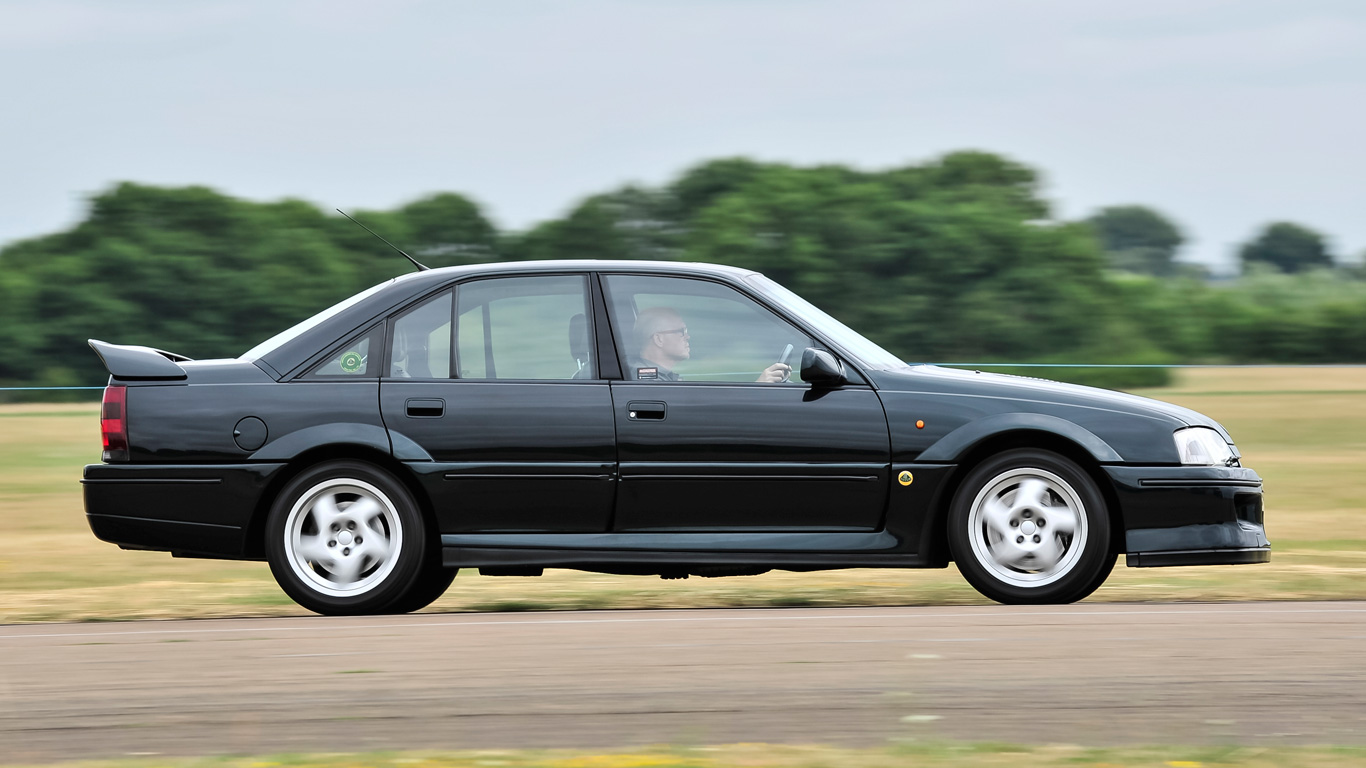This week, the internet has been awash with reviews of the new Lotus Emeya. In range-topping ‘R’ guise, this 905hp electric ‘Hyper GT’ can rocket to 62mph in 2.8 seconds and reach 159mph. Back in the early 1990s, however, a Lotus-badged saloon went even faster – at least in terms of top speed…
“Our urban panda cars can only go at 90mph,” complained a certain PC Oliver at the time. The controversial Lotus-tuned Vauxhall Carlton, meanwhile, could hit 62mph in 5.4 seconds and it didn’t stop accelerating until 176mph. Able to keep pace with a Ferrari Testarossa, it was the fastest four-door money could buy.
Lotus started with a Vauxhall Carlton GSi, boring out the standard car’s 3.0-litre engine to 3.6 litres, then adding twin Garrett turbochargers to boost output to 382hp.
Just 950 Lotus Carltons were sold, with around 285 making it to the UK (the exact number is contested, but the ‘How Many Left’ website lists 40 still on the road and 141 SORN at last count). Vauxhall and Opel intended to build 1,100 cars, but the economic recession made selling a £48,000 Carlton trickier than hoped.
How does it drive?

Despite living a charmed life, even Vauxhall’s own ex-press car feels a bit baggy at first. The manual gear change – linked to a six-speeder plucked from GM’s parts bin – has a huge throw, while the power-assisted steering feels a little disconnected at town speeds.
From behind the wheel, the only thing suggesting this car is anything but ordinary – six-cylinder warble aside – is the clutch, which requires a committed shove from your left leg.
Once out on the open roads, though, things start to tighten up enormously. Shove the accelerator pedal and it’ll hurtle towards the horizon with little in the way of lag from its twin turbochargers. It’s a surprisingly torquey unit, willing to pull in almost any gear, and the thrust just keeps on coming as the revs rise.
Even 28 years after production ended, this big-hearted, Lotus-tweaked engine feels like an all-time great.

This isn’t not a one-trick pony, either. Although the Lotus Carlton looks big with its butch bodykit, it’s actually quite a small car by today’s standards. Combine this with excellent visibility (a low window line and narrow pillars help here) and you soon feel confident enough to push on a bit.
The 265-section rear tyres and standard limited-slip differential aid traction, but there are no fancy-pants electronics to help out if it does go wrong. As you’d expect, it feels a very analogue car to drive, yet it also remains very composed – whether you’re trundling along or mimicking a 1990s ram-raider.
The Carlton’s clever self-levelling multi-link rear suspension was very sophisticated for the time and while the ride errs on the firm side, it’s still more compliant than many modern performance cars.
Tell me about buying one

Although fewer than 300 Lotus Carltons were officially sold in the UK, it was considered a classic car from the off, meaning it’s probably easier to find one today than a lesser GSi 3000.
Not so long ago, £10,000 would have bought you a good example, but – like other cult cars from this era – prices have shot up. A search of the Pistonheads classifieds reveals just one car currently for sale, priced at a not-inconsiderable £99,995.
It’s worth paying strong money for a good one, though, as sourcing parts and fixing a bad example could turn into a real headache. While stone chips are common and can be touched up, damage to the fibreglass bodykit will be much pricier to repair.

Get a history check done and look out for signs of crash damage – many Lotus Carltons have inadvertently left the road in the past. Rust can also be an issue.
During a test-drive, make sure the car tracks in a straight line without pulling to either side during braking. With hefty discs all round, the Lotus Carlton should also stop quickly, so feel for any unusual vibrations or juddering.
Vauxhall Lotus Carlton: Verdict

I fully expected to be disappointed by this car. I had a guide to supercars when I was growing up in the 1990s, and the Lotus Carlton page was flicked to more than any other. The fact that a family saloon could have such outrageous performance warped my young mind.
Even taking a relatively grown-up view today, this car is incredible. In some ways, it does feel 31 years old, but the performance on offer is still exciting. And what’s even better is how involved you are in the driving process.
While prices have catapulted the Lotus Carlton into dream car territory for most of us, if you find a good one, and have the means to buy it, I wholeheartedly suggest you do so.
Promise me one thing, though. This is a car to be used and enjoyed, not to be polished and locked away in a garage. Its thuggish appearance means it will be tutted at classic car shows for a while yet, so don’t bother. Just get out there and drive it.



[…] of 603hp, and can accelerate from 0-62mph in 4.15 seconds. A top speed of 155mph cannot match the infamous Lotus Carlton from the 1990s, […]
[…] also translates into serious performance, with 0-62mph in less than 2.5 seconds and a potential top speed of nearly […]